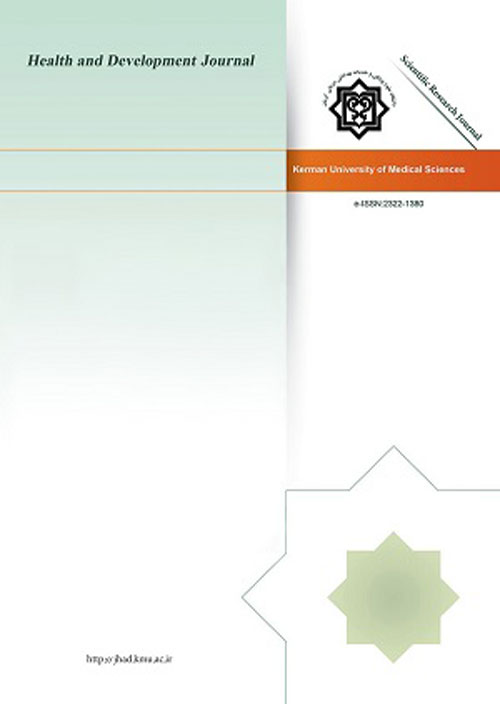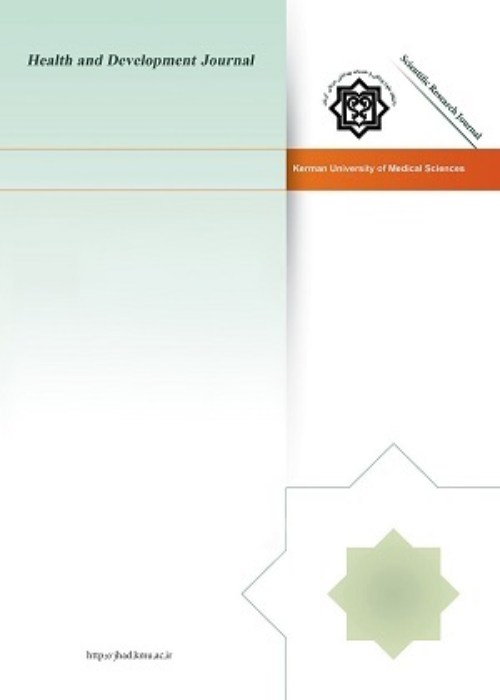فهرست مطالب

Health and Development Journal
Volume:9 Issue: 3, 2021
- تاریخ انتشار: 1399/11/29
- تعداد عناوین: 8
-
-
صفحات 273-283
-
Pages 233-243Background
Microbial contamination in water is often related to human feces. This research was conducted to investigate the microbial contamination of drinking water and some parameters affecting this contamination in the city of Kuhdasht.
MethodsIn this cross-sectional study, a total of 132 water samples were collected. The presence of total and fecal coliforms was evaluated by the Enzymatic Assay method. Heterotrophic plate count (HPC), residual chlorine, turbidity, pH, and temperature were also measured according to standard methods. The Correlation between parameters was evaluated by the Spearman test using SPSS-20 software.
ResultsThe results showed that total coliform was present in 6.8% and fecal coliform in 6% of the samples. The mean HPC, chlorine, turbidity, and pH were respectively 31.71 CFU/ml, 0.38 mg/l, 0.58 NTU, and 7.52. Correlation coefficients between T.Coli, E.Coli, and HPC with residual chlorine were -0.235, -0.175, and -0.142 and with turbidity were -0.010, 0.005 and 0.013, respectively. Turbidity, pH, and HPC were desirable in 100% of the samples, but residual chlorine was undesirable in 33%.
ConclusionThe results show, the effect of residual chlorine and turbidity on the presence of microbial contaminants in drinking water. In areas with higher chlorine, less microbial contamination was observed, and conversely, in areas with higher turbidity, less residual chlorine was observed, resulting in more microbial contamination. Therefore, control of residual chlorine level and turbidity in drinking water is very important.
Keywords: Drinking Water, Fecal coliform, Total coliform, Enzymatic Assay -
Pages 244-253Background
Infection prevention is a basic issue in the dental profession and the transmission of infectious diseases is an important issue in dentistry. The present study was performed to evaluate the risk of infection transmission by students in the restorative department of the School of Dentistry using the Six Sigma model.
MethodsThis cross-sectional study was performed in the first three months of 2016. The subjects of the study consisted of 265 dentistry students in the restorative department of the dental school, 30 of whom were randomly selected as the sample. Data were collected using a standard checklist. Using the fish bone diagram, the causes and the most important defects were identified and the Six Sigma model was used to analyze the quality of the process.
ResultsFifty-nine defects were detected in the restorative department. The most important defects which were identified as the first three factors, respectively, were: the lack of skills, experience and education of dental students in infection control, not washing of hands by dentists before wearing latex gloves, and not pressing the water and air poar for 15 seconds before use for each patient.
ConclusionThe results of the study showed that knowledge of students about infection control is insufficient and there is a need for more education with strict supervision in this field.
Keywords: Infection transmission, Six Sigma, Dental students -
Pages 254-262Background
Considering that the health of workers is largely dependent on the performance of industrial occupational health experts, the existence of standard tools to evaluate their performance will help ensure the health of workers. The objective of the present study was to weight and rank the items and subscales of the checklist for evaluating the performance of industrial occupational health experts using the analytic hierarchy process (AHP).
MethodsThis cross-sectional study was conducted on the checklist notified by the Ministry of Health and Medical Education. The checklist contained 48 items categorized into five subscales including general activities, education, occupational medicine, occupational health, and safety. The paired metrics of the items and subscales were prepared and given to 4 occupational health inspectors of the Ministry of Health for scoring. Then, the items were weighted using the analytic hierarchy process (AHP) and Expert Choice software (version 11).
ResultsA comparison of the items showed that the occupational health subscale with a weight of 28.7 had the highest weight followed by the occupational medicine subscale with a weight of 21.6, and the education subscale with a weight of 17.4. The lowest value was given to the general activity subscale with a weight of 15.9.
ConclusionIndustrial occupational health experts are recommended to pay more attention to the subscales with a higher weight because of their significance in achieving their ultimate goal, which is to maintain the health of workers.
Keywords: evaluation, performance, Occupational Health Experts, Industries, Analytic Hierarchy Process -
Pages 263-272Background
The radiology staff face many stressful situations in the hospital that can cause problems for them. Social support and self-efficacy are some of the factors that may have an inhibitory effect on occupational stress. The objective of this study was to determine the relationship of social support and self-efficacy with occupational stress in radiology staff of Amol hospitals in 2018.
MethodsThis was cross-sectional study. A total of 200 radiology staff of Amol Hospitals were selected by stratified random sampling. The data collection tools were the social support questionnaire by Zimet et al., the self-efficacy questionnaire by Nezami et al., and the occupational stress questionnaire by Parker and Dekotis. To analyze the data, Pearson correlation coefficient and multiple linear regression were used in SPSS software version 24.
ResultsThere was a significant inverse relation between social support and occupational stress (p<0.001), and also between self-efficacy and occupational stress (p<0.001). The results of multiple linear regression indicated that social support with the highest beta value was the best predictor of occupational stress (P<0.001).
ConclusionPeople with high social support have a greater sense of personal accomplishment and are less stressed and anxious when working. Furthermore, people with high self-efficacy feel more positive about their work and their ability to cope with occupational stress and problems.
Keywords: Social support, self-efficacy, Occupational stress, Radiology Staff -
Pages 273-283Background
The issue of development is the concern of many countries and since no one will be satisfied with their life without health, the establishment of health in the fundamental principles of development is inevitable. Therefore, this research investigated the development status of the cities of North Khorasan province in terms of health and treatment indicators.
MethodsThe present study was an economic evaluation. The statistical population consisted of all 8 cities of North Khorasan province, which were ranked based on 30 selected health and treatment indicators proposed in 2016, and their level of development was determined using the numerical taxonomy method. The data were entered into Excel 2010, and SPSS software version 23 was used to calculate the descriptive statistics including mean and standard deviation.
ResultsThe highest level of development was found in Bojnourd with Fi=0.416011 as relatively developed, and the lowest was in Raz and Jargalan with Fi=0.925874 rated as undeveloped. Moreover, other cities were respectively ranked as follows: Esfarayen Fi=0.572835, Jajarm Fi=0.617056, Shirvan Fi=0.627777, Farooj Fi=0.729569 as less developed, and Maneh Va Samalqan Fi=0.793439 and Garmeh Fi=0.847409 as undeveloped.
ConclusionIt is essential that national and provincial planners adopt policies to equitably allocate health and treatment facilities to the cities of the province, so that it leads to sustainable development.
Keywords: Numerical Taxonomy, Health, Treatment Indicators, Development -
Pages 284-294Background
Enhancing economic growth and consequently the growth of economic sub-sectors is one of the important goals of any country and is always considered by policymakers. Accordingly, the present study aimed to examine the impact of permanent and temporary monetary shocks on the value-added of the Iranian health sector.
Materials and MethodsThe present study conducted an econometric and time series analysis of the Iranian health sector. The data on the research variables including the value-added of the health sector and the money supply for the period from 1973 to 2011 were received from the Central Bank of the Islamic Republic of Iran. Eviews software (version 8) was used for data analysis and the Blanchard-Quah method and the SVAR model were used to separate permanent and temporary monetary shocks and analyze their effects on the economic growth of the health sector.
ResultsThe results of the study showed a positive relation between monetary shocks and the growth of the Iranian health sector, with permanent monetary shocks showing the greatest impact. However, monetary shocks had a short-term effect on the value-added of the health sector, so that both types of shocks are moderated after 5 years and their effect disappears. Accordingly, it can be argued that the growth of the money supply had short-term effects on the growth of the health sector.
ConclusionThe findings of this study suggested the adoption of the money supply increase policy in an economy leads to inflation and has no real impact on the growth of the health sector. Therefore, the Iranian central bank must adopt policies to control the money supply in the economy.
Keywords: Monetary Shocks, Economic Growth, Health sector, Blanchard-Quah method -
Pages 295-308Background
Determining the development level of various communities paves the way for accurate planning. The present study provides an analysis of health care development in the counties of Yazd province using 22 health indicators.
MethodsThe present study was conducted using an economic and retrospective approach. The data in this study were collected in 2016 using a documentary study. Besides, the analytic hierarchy process and the entropy method were used to weight the indicators, and the VIKOR method and Sturges' rule were used to analyze the data and to rate the counties with SPSS software (version 22).
ResultsYazd province with an average Q value of 0.43 does not have a favorable position in terms of the development of health services. It was also shown that Taft and Saduq counties had the highest and lowest levels of health care development, respectively.
ConclusionGiven that Yazd province in general and its counties, in particular, were not in a favorable situation in terms of health care indicators, the components such as education, health care, treatment, and housing need to be considered the priority of human development programs in the 10 counties of Yazd province. Furthermore, regardless of variables such as population, administrative-military densities, and size, individual factors like gender, literacy, and awareness as well as economic factors such as income need to be taken into account in development programs.
Keywords: Spatial Distribution, Development, Health Care, Health Indicators, Negative Entropy -
Pages 309-320Background
The objective of this study was to investigate the general health status of Kerman citizens and some related factors.
MethodologyThis cross-sectional and descriptive-analytical study was conducted in autumn of 2016. The statistical population included all citizens over 18 years old in Kerman. Using multistage sampling method, 400 individuals were selected as the sample. The utilized instruments were Goldberg General Health Scale (GHQ-28) and a questionnaire containing demographic, background, and social class information. Data were analyzed using SPSS-23 software as well as descriptive statistics, independent t-test and one-way ANOVA.
ResultsThe mean and standard deviation of the respondents' general health score was 28.66±12 12.83. Most respondents (63.7%) had some degree of physical and mental problems and thus were not in good general health status, of which 48.5% had mild symptoms, 12.2% had moderate symptoms, and 3% had severe symptoms. Moreover, men had higher general health than women (P=0.011). However, there was no significant relation between general health and age (p=0.424), marital status (p=0.211), area of residence (p=0.300), and social class (P=0.183).
ConclusionMore than half of the respondents had some degree of physical and mental problems and were not in good general health status. It is recommended that periodic screening as well as providing necessary training and consulting services be emphasized in order to improve the general health of citizens.
Keywords: General health, GHQ-28 Questionnaire, Personal, Social Factors, Kerman Citizens


